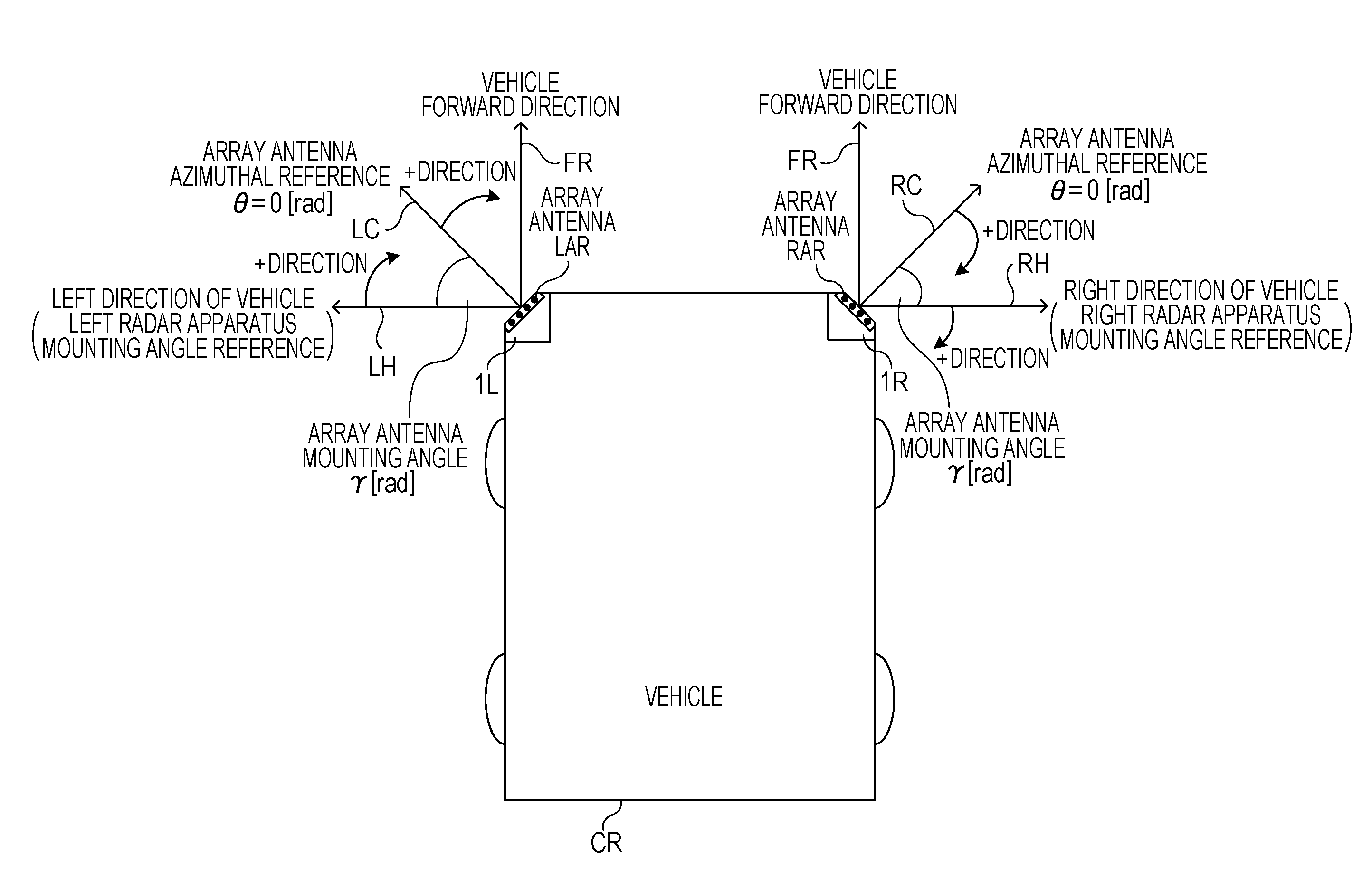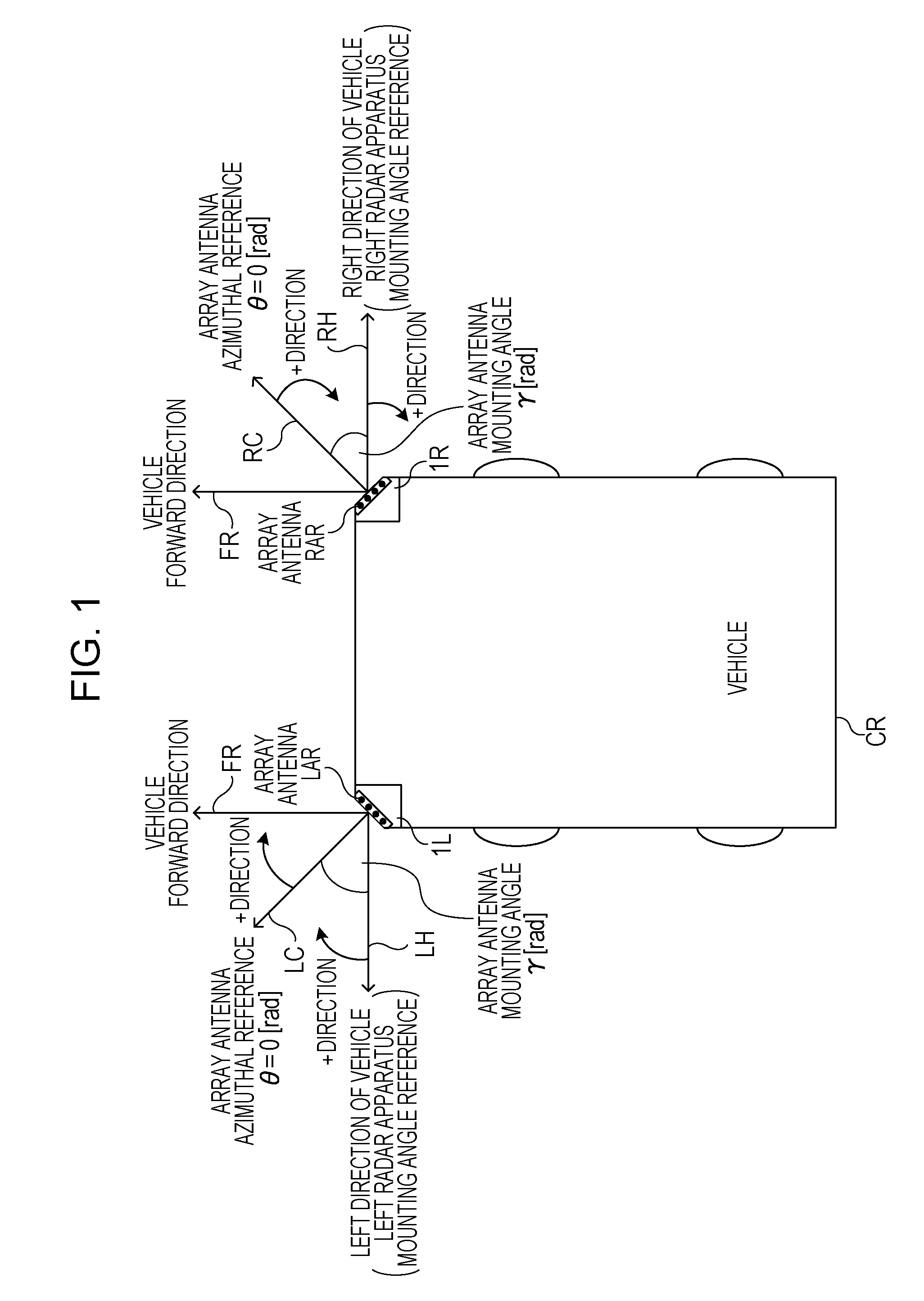Radar apparatus
- Summary
- Abstract
- Description
- Claims
- Application Information
AI Technical Summary
Benefits of technology
Problems solved by technology
Method used
Image
Examples
first embodiment
[0025]FIG. 1 is a diagram illustrating a relationship between a vehicle coordinate system and a radar coordinate system viewed from above. In a first embodiment, for example, the vehicle CR includes two radar apparatuses 1L and 1R at front left and right corners thereof, respectively, relative to a forward direction FR, but the vehicle CR may include two radar apparatuses at rear left and right corners thereof.
[0026]In FIG. 1, a mounting angle γ of a plurality of reception antennas (hereinafter referred to as an “array antenna”) of the radar apparatus 1L is the angle of a direction LC perpendicular to an opening of an array antenna LAR of the radar apparatus 1L relative to a left direction LH of the vehicle CR, which is a reference mounting angle of the left radar apparatus 1L. The mounting angle γ of the array antenna LAR of the radar apparatus 1L increases clockwise (γ>0) from the reference angle (0 [rad]), which is the left direction LH of the vehicle CR. The direction LC perpend...
second embodiment
[0157]In a second embodiment, a radar apparatus 1A including a radar transmission unit TxA that switches a main beam direction of a radar transmission signal instead of the radar transmission unit Tx of the radar apparatus 1 according to the first embodiment will be described with reference to FIG. 7. The radar apparatus 1A according to the second embodiment may be applied to a radar apparatus C according to a fourth embodiment, which will be described later (refer to a radar apparatus 1D illustrated in FIG. 11).
[0158]FIG. 7 is a diagram illustrating the internal configuration of the radar apparatus 1A according to the second embodiment. The radar apparatus 1A illustrated in FIG. 7 includes the reference signal generation unit Lo, a transmission beam control unit Be, the radar transmission unit TxA, and a radar reception unit RxA. Description of the radar apparatus 1A according to this embodiment that is the same as description of the radar apparatus 1 according to the first embodim...
third embodiment
[0174]In a third embodiment, a radar apparatus 1B that repeatedly transmits a radar transmission signal (for example, chirped pulses of a frequency-modulated continuous wave (FMCM)) subjected to frequency modulation performed by a radar transmission unit TxB will be described with reference to FIGS. 8, 9A, and 9B.
[0175]FIG. 8 is a diagram illustrating the internal configuration of the radar apparatus 1B according to the third embodiment in detail. FIG. 9A is a diagram illustrating a relationship between a frequency-modulated transmission signal and transmission periods. FIG. 9B is a diagram illustrating a reflection reception signal, which is the frequency-modulated transmission signal illustrated in FIG. 9A reflected from a static target or a moving target. Description of the radar apparatus 1B according to this embodiment that is the same as description of the radar apparatus 1 according to the first embodiment is simplified or omitted, and differences will be mainly described.
[01...
PUM
 Login to View More
Login to View More Abstract
Description
Claims
Application Information
 Login to View More
Login to View More - R&D
- Intellectual Property
- Life Sciences
- Materials
- Tech Scout
- Unparalleled Data Quality
- Higher Quality Content
- 60% Fewer Hallucinations
Browse by: Latest US Patents, China's latest patents, Technical Efficacy Thesaurus, Application Domain, Technology Topic, Popular Technical Reports.
© 2025 PatSnap. All rights reserved.Legal|Privacy policy|Modern Slavery Act Transparency Statement|Sitemap|About US| Contact US: help@patsnap.com



